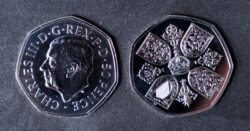To view this video please enable JavaScript, and consider upgrading to a web
browser that
supports HTML5
video
Production of the country’s new coins, featuring the portrait of King Charles instead of the Queen, has begun.
Royal Mint said the move, which represents the biggest change to UK coinage since decimalisation, will ‘usher in a new era’.
In the new coin, Charles faces to the left, the opposite direction to his mother. This is because tradition states monarchs face the opposite way to their predecessors.
Protocol also dictates that Kings do not wear crowns in their portraits on coins, while it is the opposite for female royals.
Production of coins featuring the Queen will conclude by the end of the year.
The 27 billion coins bearing her portrait of the late monarch will remain legal tender, but be replaced over time as they become damaged or worn and to meet demand.
Kevin Clancy, director of the Royal Mint Museum, said: ‘For many people this will be the first time in their lives that they have seen a new monarch appear on money.
King Charles will adorn millions of new coins across the UK (Picture: PA)
‘It represents the biggest change to UK coinage since decimalisation and will usher in a new era where the coins of Queen Elizabeth II and Charles co-circulate in the UK.’
A memorial 50 pence in honour of the Queen will also appear in the public’s change through banks and post offices from December.
Workers at the Royal Mint in Llantrisant, south Wales, will produce 9.6 million copies of the coin to mark the Queen’s death at the age of 96.
The reverse of the 50p features the design that originally appeared on coins to commemorate her coronation at Westminster Abbey in 1953.
The first coins featuring the portrait of King Charles III are struck at the royal Mint in Pontyclun, Wales (Picture: PA)
It includes the four quarters of the Royal Arms depicted within a shield, with emblems of the home nations – a rose, a thistle, a shamrock and a leek.
The coins will be made on demand in line with the wishes of the King and the late Queen, who asked for minimal waste during the process.
The 50 pence coin was chosen as it is one of the most popular for people to start collecting.
Rebecca Morgan, director of collector services at the Royal Mint, confirmed that ‘nothing is removed or changed just for change’s sake’.
For many, the Queen has been all people have ever known on the country’s currency (Credits: Bloomberg via Getty Images)
She said: ‘I think it is really poignant that the King’s first coins are in tribute to his late mother.
‘The only difference on the reverse of the coin is the date on either side of the leek, which is 2022 rather than 1953.’
It takes between 18 months to two years to design a coin, with the monarch personally signing off each one.
Before her death, the Queen signed off a number of coins – including a Harry Potter commemorative series – and production of these will continue.
The Queen will feature on commemorative coins to mark 25 years since the novel Harry Potter and the Philosophers Stone by J.K. Rowling was first published (Picture: PA)
This will mean that two of the Harry Potter series will feature the Queen, with the final two bearing the portrait of the King.
Acclaimed British artist Martin Jennings, who usually works in bronze and stone, designed the official portrait of Charles to be struck onto coins.
‘It has been a big design challenge,’ he said.
‘The placing of everything is exactly precise, such as the spacing between the letters, the proximity with the head.
‘It is a huge honour. It is extraordinary to think that the smallest piece of work that I have ever done is that one that is going to be reproduced in the most multiples.’
Previous works by Mr Jennings include a sculpture of poet Sir John Betjeman at St Pancras Station, one of nurse Mary Seacole by Westminster Bridge and a bronze bust of the Queen Mother at St Paul’s Cathedral.
To make the 9.6 million coins, four presses will be running for 16 hours a day at the Royal Mint’s site.
Each press can strike 400 coins per minute, making around 20,000 coins an hour.
The coins are checked and counted before being packed into cartons of 100,000, which are then sent to banks and sorting offices across the country.
Get in touch with our news team by emailing us at [email protected].
For more stories like this, check our news page.
To make the 9.6 million coins, four presses will be running for 16 hours a day at the Royal Mint’s site.





